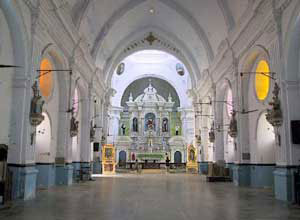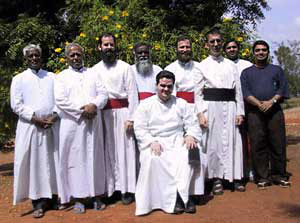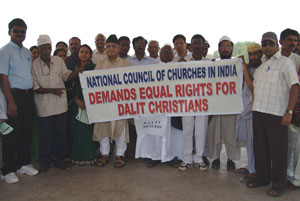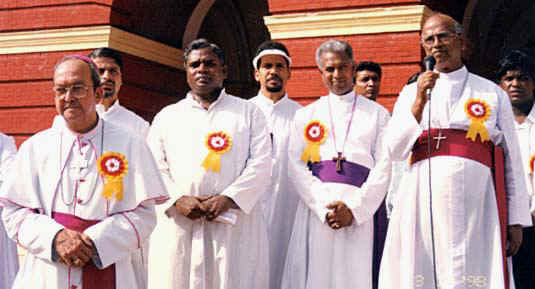Christianity in India

Christianity originates in Israel. The first Christians were Jews and in the beginning Christianity was seen as a Jewish cult. Most of the Apostles of Christians acted in Europe to convert the Europeans to Christianity. But one of the Apostles, St. Judas Thomas, arrived in India and converted Indians to Christianity. St. Thomas was a carpenter and a disciple of Jesus. He was brought to India by a merchant to build a temple. St. Thomas arrived in Kerala, in south India in 52 AD. He succeeded in converting local Indians to Christianity. His converts were called Syrian Christians. One assumption says that some of the Syrian Christians were actually Jews converted by St. Judas Thomas to Christianity. The disciples of Jesus at first intended to convince the Jews to adopt the philosophy of Jesus as new Judaism. Later on other Christian saints arrived to India as missioners. But most of the Indian were converted to Christianity by the missionaries who arrived in India with the European powers from 15th century.
The European powers arrived in India for commercial reasons, especially spices. But they also started converting local Indians to Christianity. Five European countries sent their representatives to India, Great Britain; France; Denmark; Netherlands and Portugal. Of the five European powers the Portuguese were most enthusiast to baptize Indians. The Portuguese were the first European power to arrive in India. Their first ship, under the leadership of Vasco DaGama, arrived in south India in 1498 after it had circled the whole continent of Africa. The Portuguese inspired by the Pope’s order to baptize people around the world not only fought wars against the local Indian rulers, but they even tried to enforced their Roman Catholic prayers on Syrian Christians.
After many wars the Portuguese were defeated by local rulers and they had only one big pocket of control in India, Goa. The Portuguese not only fought the Indian rulers, but they also fought against other European powers in India especially Dutch and English. Many Portuguese churches in Kerala were turned into English and Dutch churches after they were captured by these powers.

The British church missionaries succeeded less than the Portuguese in converting Indians to Christianity, but unlike the Portuguese who tried to enforce Christianity, these Protestant converts were voluntary. The Portuguese were also aware of the Indian custom according to which the wife followed her husband’s faith and therefore married their men to Indian women.
There are about 30 million Christians in India. The major centers of Christianity in India are Kerala, Tamil Nadu, Goa, Manipur and Mizoram. There is also a big community of Christians in Mumbai. The main division of Christians in India is like in the Christian world, Protestants and Catholic. There are also different denomination among them, Syrian Church, Armenian Church, Anglican Church and others. Most of the India Christians were converted by the Portuguese.
There is also an Anglo-Indian community in India.
Dalit Christians

Conversion to Christianity has not redeemed 19 million Dalit Christians from social discrimination and untouchability. It has only added to their misery. Conversion disqualifies a Dalit Christian from constitutionally guaranteed protection and privileges. The Dalits accepted the new faith in Jesus Christ with some hope that they would regain their lost humanity and they would be considered as God’s children. But in reality, it is only a dream. As Christians, they continue to suffer and live all human misery both in the society and in the Church.
The Church in India is a Dalit Church, because 70% of India’s 25 million Christians are Dalits. Although Dalits form the majority in all these churches, their place and influence in these churches are minimal or even insignificant. Their presence is totally eclipsed by the power of the upper-caste Christians who are only 30% of the Christian population. This is all the more true in the case of the Catholic Church where such discrimination is strongly felt. There have been regular complaints that Dalit Christians are denied admission and appointments in Church-run educational institutions to favour upper caste Christians.
In the Catholic Church, the Dalits form the majority, almost 70%: but it is the higher caste-people, only 30% of church population, who control the Church by occupying the key position. The majority of the catholic bishops and clergy, the religious and lay leaders, come from the upper castes. One can say that this 30%, the upper caste, occupy the 90% of the administration and leadership of the church. Thus the dalits are pushed aside and reduced to insignificance in their own homeland. Today this trend has become a major matter for concern in the church.

– source adaniel info blog
– Wikipedia
Buddhachannel Diffusion – www.buddhachannel.tv




